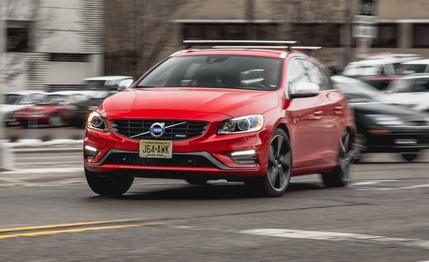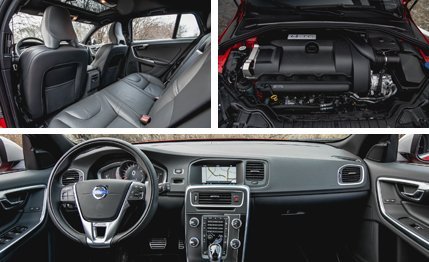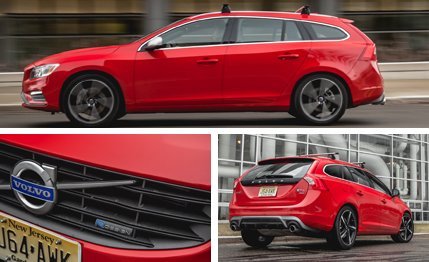 Instrumented Test
Instrumented Test
The inherent balance of an inline six-cylinder engine makes it appealing to drivers like us, and it contributed to the legendary status of historic cars such as the Nissan Skyline, several Jaguars, and many BMWs. The unbent six is a dying breed, though, becoming more rare every model year, kind of like station wagons and clutch pedals.
Volvo has pretty much given up on clutch pedals but still offers both a wagon and a straight-six. The latter, we’re told, will continue indefinitely even as the Chinese-owned Swedish brand has sworn fealty to a future that’s all about threes and fours and hybrids.
The only way to get a Volvo V60 with the 3.0-liter turbocharged inline-six (rather than the 2.0-liter Drive-E turbo four or the 2.5-liter turbo five-cylinder) is to choose the top T6 R-Design model and all-wheel drive. That car, as tested here, also wears a Polestar badge on its tail, referencing the standard software upgrade from Volvo’s racing partner that lifts output to 325 horsepower and 354 lb-ft, compared to 300 and 325 for the same engine as installed in the S80 sedan.
The car tested here is marketed as a 2015.5 model, which means that Volvo upgraded the in-dash infotainment system to incorporate some of the features on the all-new XC90, including 3G connectivity (Sensus Connect) and Sensus Navigation (which can receive routes sent from your phone or computer and includes free map updates "as long as the system is in production"), plus power lumbar support for the seats. Otherwise, it’s pretty much the same as the 2015 model that we ranked third in an earlier comparison test against the Audi Allroad and the BMW 3-series wagon. Aiming to show that these Euro-wagons make good alternatives to crossovers, the comparison wasn’t quite apples to apples—Volvo did not yet have the V60 Cross Country model that will match up more directly against the Allroad, as it packs a raised suspension, less power, and a lower price tag. The T6 R-Design actually has a lowered suspension and a more performance-oriented mission. That’s why it forms the basis for the limited-edition, Polestar-branded models of the S/V60, which have proved popular enough that Volvo now plans to make more of them than it originally announced.

The sticker on this example bumped right up to near $50,000 with only three options: $925 for a blind-spot warning system, $750 for 19-inch wheels with summer performance tires, and $1550 for the Climate package that puts heaters in the seats (front and rear), the steering wheel, the windshield, and the washer-fluid nozzles. It would take another $12,000 to get into a high-performance Polestar wagon and more than $10,000 extra to buy the Polestar sedan we tested recently.
The differences between the T6 R-Design and the Polestar don’t look that huge at the track. This car got to 60 mph in 4.9 seconds versus 4.5 for the Polestar sedan, which has 20 more horsepower and weighs 117 pounds less. Our wagon ran the quarter-mile in 13.5 seconds at 105 mph, only 0.4-second and 2-mph slower than the Polestar. We managed 0.88 g on the skidpad versus the Polestar’s 0.91, and the wagon stopped from 70 mph in only 157 feet (8 more than the Polestar sedan). This latter figure was a pleasant surprise—the comparison-test V60 triggered complaints of a squishy pedal and needed 20 feet longer to stop. Meanwhile, the full-bore Polestar version of this car gets six-pot Brembo calipers up front as one of its hardware upgrades.
What these numbers don’t tell you is that the T6 R-Design doesn’t feel as sweet and responsive as the Polestar edition. The steering responds less promptly, and shifts from the six-speed transmission feel lazier. The standard tune on the Haldex all-wheel-drive system likewise takes a moment before transferring torque to the rear axle, contributing to power understeer and reluctant turn-in. Overall, the T6 R-Design feels like a hot-rodded version of the V60, a little ponderous and clunky, while the Polestar has a more refined, sophisticated tune that feels as smooth and balanced as its straight-six.

The infotainment upgrades work well enough while relying on the same hardware for the interface (who else still has a full telephone keypad on the dash?). It even seems to respond more promptly than before, addressing one of the complaints we had in last year’s comparison test. And the motorized lumbar improves on the seats, which we’ve lauded for their mix of support and long-range comfort. One way to look at all this is to say the T6 R-Design comes pretty darned close to the Polestar version’s performance at a 20- to 25-percent discount. That’s a lot of cash you could save while getting most of the goodness.
We remember wondering when we first drove the Polestar edition if some of the changes—like stiffer suspension bushings and mounts—shouldn’t be standard kit on the T6 R-Design. These elements, unfortunately, would be difficult for an owner to retrofit; they’re installed in Volvo’s factory.
Before Volvo lets its marketing department decide that motorsports doesn’t fit the corporate mission (yet the around-the-world sailing Volvo Ocean Race does?), it should consider other potential benefits of a relationship with a racing team. The racers seem to know something about suspension tuning that the production side could learn from—the only part of their chassis solution that might be prohibitively expensive is a set of shock absorbers from Öhlins. Recalibrating the transmission and all-wheel-drive system in the Polestar fashion shouldn’t cost much and would go a long way toward optimizing this car for the kind of customers who might otherwise shop one of the German brands.